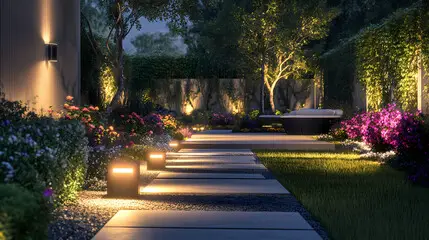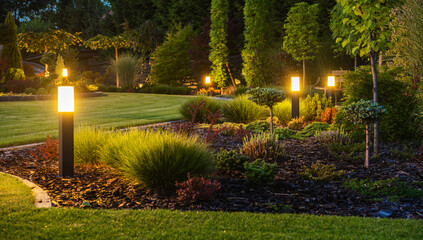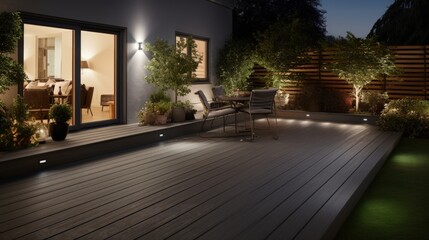How to Light Up Pathways with Landscape Lights
Pathway lighting is an integral part of landscape design, offering both practical safety and aesthetic enhancement. Whether you aim to improve visibility, highlight garden features, or create a warm, welcoming ambiance, strategically placed landscape lights can transform your outdoor space. This comprehensive guide explores the best methods for lighting pathways, ensuring beauty, security, and energy efficiency.
Why Pathway Lighting Matters
Properly illuminating pathways has numerous advantages, making it a key component of outdoor lighting design.
- Enhances Safety – Prevents accidents by clearly illuminating walkways, stairs, and uneven surfaces, reducing the risk of trips and falls.
- Boosts Curb Appeal – A well-lit landscape increases the visual appeal of your property, creating a polished, sophisticated look that boosts its value.
- Improves Security – Deters potential intruders by eliminating dark spots around your home, reducing hiding places.
- Creates Ambiance – Thoughtfully placed lighting adds warmth, depth, and elegance to gardens, patios, and home entrances, enhancing outdoor living spaces.
- Guides Movement – Defines walking paths, making navigation easier for guests and residents alike.
Types of Pathway Lighting
Selecting the right type of pathway lighting is crucial to achieving a perfect balance between function and style. Below are the most effective lighting options for pathways:
1. Solar Path Lights
- Environmentally friendly and cost-effective since they rely on solar energy.
- No need for electrical wiring, making installation quick and hassle-free.
- Best suited for areas with ample direct sunlight exposure.
- Typically feature automatic dusk-to-dawn sensors for convenience.
- Low maintenance with long-lasting LED bulbs.
2. Low-Voltage LED Path Lights
- Operates using a transformer, reducing standard electrical voltage to a safe and energy-efficient level.
- Provides bright, consistent illumination while consuming minimal power.
- Available in various styles, finishes, and brightness levels to match your landscape aesthetics.
- Ideal for illuminating long pathways, driveways, or large gardens.
- Works well in areas with less direct sunlight where solar lighting may not be effective.
3. Bollard Lights
- Taller, pillar-like fixtures that provide 360-degree illumination.
- Effective for larger properties, commercial landscapes, and driveways.
- Adds a modern and decorative touch to outdoor spaces while improving visibility.
- Available in solar, LED, and hardwired configurations.
- Works well when placed along straight paths, driveways, or open landscape areas.
4. Recessed In-Ground Lights
- Installed flush with the ground to create a sleek, modern appearance.
- Provides discreet lighting that blends seamlessly with the landscape.
- Perfect for illuminating pathways without obtrusive fixtures.
- Weather-resistant and highly durable, making them ideal for long-term outdoor use.
- Commonly used in contemporary landscape designs for a minimalist look.
5. Lantern-Style Path Lights
- Offers a more traditional, decorative appeal with hanging or mounted lantern fixtures.
- Works well for classic, cottage-style, and rustic garden designs.
- Often features intricate detailing and warm-toned lighting to create a cozy ambiance.
- Pairs beautifully with stone pathways, pergolas, and garden benches.
Placement Tips for Pathway Lights
Effective placement ensures that your pathway lighting serves both practical and aesthetic functions. Consider these guidelines when installing your lights:
- Space Lights Evenly: Position lights 6-8 feet apart for a balanced, evenly distributed glow that prevents over-brightening.
- Use a Staggered Layout: Instead of placing lights in a straight line, alternate them on either side of the path for a more natural, visually appealing look.
- Avoid Glare: Position fixtures so that the light focuses on the pathway rather than directly into people’s eyes.
- Highlight Key Features: Use additional lighting to accentuate architectural elements, trees, garden beds, or water features near walkways.
- Consider Step Lighting: If pathways include steps or elevation changes, incorporate step lights to improve visibility and prevent accidents.
- Blend Lighting Styles: Mix and match different fixture styles, such as bollards with in-ground lights, for added depth and character.
Energy-Efficient Pathway Lighting Solutions
Sustainability is a growing concern for homeowners, and energy-efficient lighting solutions can help reduce environmental impact while cutting electricity costs. Here are the best eco-friendly options:
- Solar-Powered Lights: Harness sunlight to operate without requiring wiring or electrical connections, offering a completely sustainable solution.
- LED Bulbs: Consume significantly less power than traditional incandescent bulbs while providing brighter and longer-lasting illumination.
- Smart Lighting Systems: Motion-sensor and timer-controlled lights minimize energy waste by activating only when needed.
- Dimmable Fixtures: Allows users to adjust brightness levels based on time of day and specific lighting needs, optimizing energy efficiency.
Common Mistakes to Avoid
When installing pathway lighting, avoiding these common errors ensures a functional and visually pleasing outcome:
- Overcrowding Fixtures: Too many lights can create excessive brightness, reducing the natural beauty of your landscape.
- Poor Placement: Placing lights too close together or too far apart results in uneven lighting and diminished effectiveness.
- Choosing the Wrong Brightness Level: Overly bright lights can cause glare, while dim lights may not provide enough illumination for safety.
- Ignoring Weather Resistance: Outdoor lighting must be durable and designed to withstand elements like rain, snow, and extreme temperatures.
- Neglecting Maintenance: Regularly clean lenses and check wiring or battery health to ensure consistent performance.
Conclusion
Pathway lighting is a fundamental aspect of landscape design, offering both safety and aesthetic enhancement. Whether opting for solar path lights, low-voltage LEDs, bollard fixtures, or recessed in-ground lights, choosing the right type and placing them strategically can transform your outdoor space into a beautifully illuminated and functional area. Incorporating energy-efficient solutions and avoiding common installation mistakes ensures that your lighting setup remains sustainable, stylish, and practical for years to come.


